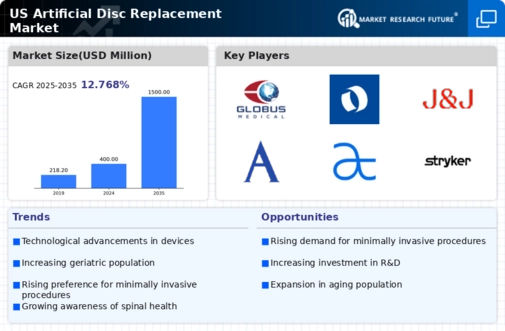The artificial disc-replacement market exhibits a dynamic competitive landscape characterized by rapid innovation and strategic maneuvering among key players. Major companies such as Medtronic (US), Johnson & Johnson (US), and Stryker (US) are at the forefront, each leveraging distinct strategies to enhance their market presence. Medtronic (US) focuses on technological advancements, particularly in minimally invasive surgical techniques, which align with the growing demand for less invasive treatment options. Meanwhile, Johnson & Johnson (US) emphasizes strategic partnerships and acquisitions to bolster its product portfolio, thereby enhancing its competitive edge. Stryker (US) appears to prioritize regional expansion, particularly in emerging markets, which may provide new revenue streams and diversify its operational risks. Collectively, these strategies contribute to a competitive environment that is increasingly driven by innovation and strategic collaborations.
Key business tactics within the market include localizing manufacturing and optimizing supply chains to enhance efficiency and reduce costs. The competitive structure of the artificial disc-replacement market is moderately fragmented, with several players vying for market share. This fragmentation allows for a diverse range of products and innovations, although it also intensifies competition among key players. The influence of major companies is significant, as their strategic decisions often set the tone for market trends and consumer expectations.
In October 2025, Medtronic (US) announced the launch of a new artificial disc designed for enhanced patient outcomes, which integrates advanced materials to improve durability and reduce wear. This strategic move underscores Medtronic's commitment to innovation and positions the company to capture a larger share of the market by addressing the evolving needs of healthcare providers and patients alike. The introduction of this product may also stimulate competitive responses from other players, further driving innovation in the sector.
In September 2025, Johnson & Johnson (US) completed the acquisition of a leading spinal device manufacturer, a move that is likely to expand its technological capabilities and product offerings in the artificial disc-replacement segment. This acquisition not only strengthens Johnson & Johnson's market position but also reflects a broader trend of consolidation within the industry, as companies seek to enhance their competitive advantages through strategic mergers.
In August 2025, Stryker (US) entered into a partnership with a prominent research institution to develop next-generation artificial discs utilizing AI-driven design processes. This collaboration highlights the increasing importance of technology integration in product development and suggests that Stryker is positioning itself to lead in innovation. Such partnerships may also facilitate knowledge sharing and accelerate the pace of advancements in the market.
As of November 2025, current competitive trends are increasingly defined by digitalization, sustainability, and the integration of AI technologies. Strategic alliances are becoming more prevalent, as companies recognize the value of collaboration in driving innovation and enhancing product offerings. Looking ahead, competitive differentiation is likely to evolve, shifting from traditional price-based competition to a focus on technological innovation, supply chain reliability, and sustainable practices. This transition may redefine market dynamics, compelling companies to invest in R&D and forge strategic partnerships to maintain their competitive edge.























Leave a Comment